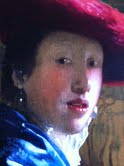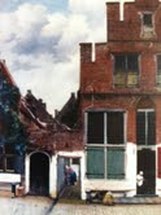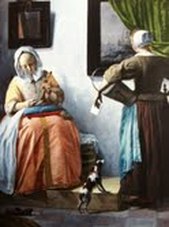
This exhibit is particularly important for us to increase our understanding of an artistic period, different from the Italian, with whom we have no familiarity.
| It includes a selection of works by Vermeer together with paintings from major artists mainly from the city of Delft, one of the most important cultural centre of Holland. The exhibit explore the genius of this artist and help understanding the cultural ferment of his native city, and of the nearby centers such as Amsterdam, Haarlem and Leyden. There are six wonderful Vermeer’s works and over 50 paintings by Carel Fabritius, Vermeer's acknowledged master who died in the gunpowder store explosion of 1654, by Pieter de Hooch and by Emmanuel de Witte, together with work by artists including Gerard ter Borch, Gerrit Dou, Nicolaes Maes, Gabriël Metsu, Frans van Mieris, Jacob Ochtervelt, Jan Steen and numerous other sophisticated and remarkable painters. The fortunate period in the history of art of the 17th century Dutch painting tradition is perfectly expressed in this exhibit. The rich Dutch middle class, in these same period Holland had the greatest commercial fleet in the world, was commissioning work of art aimed to commemorate their social and economical achievement by simply representing their daily life, their beautiful homes with marble floors and rich furniture and carpets and their city. The themes are mainly private as the family, the gestures and moments of daily life, reading and writing, courting, playing music and the study of science. In Delft, in the 17th century, the painters were 50, an imposing number if compared to the city inhabitants that were 25.000. The commissions were mainly little paintings, differently to what happened in Italy were big paintings were committed and usually depicted religious subjects. The religious aspect influenced the 17th century Dutch art as in the Calvinism religion sacred images and saints were not aimed to be worshiped and represented, so the subject turned into either depicting the city or private life. I found this exhibit particularly enjoyable both for the amazing technical skills of the artists and because of the intimate and daily subjects represented. The Scuderie del Quirinale, Rome, via XXIV Maggio 16. Opening hours: Sunday to Thursday 10.00am to 8.00pm Friday and Saturday 10.00am to 10.30pm Admission ticket 12 euro. Until January 20th |





